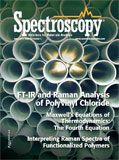Spotlight
What role can mid-infrared (mid-IR) spectroscopy play in protecting the environment and human health? That is precisely the question being addressed by Mid-Infrared Technologies for Health and the Environment (MIRTHE), a National Science Foundation-Engineering Research Center founded in 2006 at Princeton University (Princeton, New Jersey) and five partner institutions.
What role can mid-infrared (mid-IR) spectroscopy play in protecting the environment and human health? That is precisely the question being addressed by Mid-Infrared Technologies for Health and the Environment (MIRTHE), a National Science Foundation-Engineering Research Center founded in 2006 at Princeton University (Princeton, New Jersey) and five partner institutions. The center's goal is to develop mid-IR optical-trace gas sensing systems that can detect minute amounts of chemicals in the environment or atmosphere, including both naturally occurring chemicals and industry contaminants. To learn more about this work, we recently spoke to Jon Sobus, PhD, of the United States Environmental Protection Agency (EPA) about how mid-IR technologies are being used in the EPA's Office of Research and Development (ORD). Sobus spoke on this topic last fall at a conference organized by MIRTHE.
What types of analyses does your office do?
Sobus: EPA's ORD has a diverse research portfolio focused on evaluating, monitoring, and sustaining ecosystems and human health. Research often involves the analysis of environmental media (such as soil, dust, air, surface water, ground water, and drinking water), personal media (such as food and consumer products), and biological media (such as blood, urine, breath, and cells) from living intact organisms or surrogate systems. Target analytes in these media generally include naturally occurring (such as radiation) or anthropogenic stressors (such as air toxics and pesticides), or stress response markers (such as inflammation).
How do you make connections between exposure to stressors and the effect on environmental or human health?
Sobus: EPA's mission is to protect human health and the environment. In carrying out our mission, EPA scientists assess and manage risks posed by environmental stressors. Generally, a stressor is first identified as "hazardous" to environmental or human health, or both. Next, a dose-response assessment determines the level at which a stressor becomes hazardous. Exposure assessment then informs us about the sources, routes, and magnitude of exposure to a population of interest. If exposures are deemed unacceptable, mitigation may be performed to reduce health risks. The primary steps of this process (hazard identification, dose-response assessment, and exposure assessment) often require measurement tools. For example, measurements of environmental media inform us about exposure sources and routes, measurements of biological fluids (biomarkers) inform us about dose levels, and measurements of response to a stressor in living tissue inform us about dose-response. Connections between these measurements help define the "source-to-outcome continuum" for a given stressor. [A diagram of the source-to-outcome continuum for human health risk assessment is shown in the on-line version of this interview] (1). Mid-IR spectroscopy may prove a useful tool for obtaining these measurements.
Why is mid-IR spectroscopy well suited for this work? Is mid-IR more suitable than other approaches?
Sobus: Humans inhabit complex ecosystems that are both highly varied and dynamic. As such, intricate relationships govern human and environmental health. Understanding these relationships requires copious data and appropriate methods for interpretation. Consumer-driven products (for example, smart-phone technologies and global positioning systems) now provide near real-time data on human activities that may affect health (such as diet, physical activity, and proximity to pollution sources). Complements to these data are needed, on a highly resolved spatial and temporal scale, to provide information about health effects from exposure to environmental pollutants. Mid-IR spectroscopy is well suited to help fill this niche because instruments are becoming more portable, affordable, selective for target analytes, and sensitive for trace-level analysis. Analyses using lab-based benchtop instruments, the industry standard in many cases, can be somewhat prohibitive based on the costs (time and money) of sample collection, shipment, preparation, and so forth. Thus, there are clear benefits to methods that rapidly provide accurate and precise measurements to scientists in the field.
Reference
(1) J.R. Sobus, Y.M. Tan, J.D. Pleil, and L.S. Sheldon, Sci. Total Environ. 409(22), 4875–4884 (2011).
This interview was edited for length and clarity.
For the full interview with Sobus, please visit: www.spectroscopyonline.com/Sobus

High-Speed Laser MS for Precise, Prep-Free Environmental Particle Tracking
April 21st 2025Scientists at Oak Ridge National Laboratory have demonstrated that a fast, laser-based mass spectrometry method—LA-ICP-TOF-MS—can accurately detect and identify airborne environmental particles, including toxic metal particles like ruthenium, without the need for complex sample preparation. The work offers a breakthrough in rapid, high-resolution analysis of environmental pollutants.
Karl Norris: A Pioneer in Optical Measurements and Near-Infrared Spectroscopy, Part II
April 21st 2025In this two-part "Icons of Spectroscopy" column, executive editor Jerome Workman Jr. details how Karl H. Norris has impacted the analysis of food, agricultural products, and pharmaceuticals over six decades. His pioneering work in optical analysis methods including his development and refinement of near-infrared spectroscopy, has transformed analysis technology. In this Part II article of a two-part series, we summarize Norris’ foundational publications in NIR, his patents, achievements, and legacy.